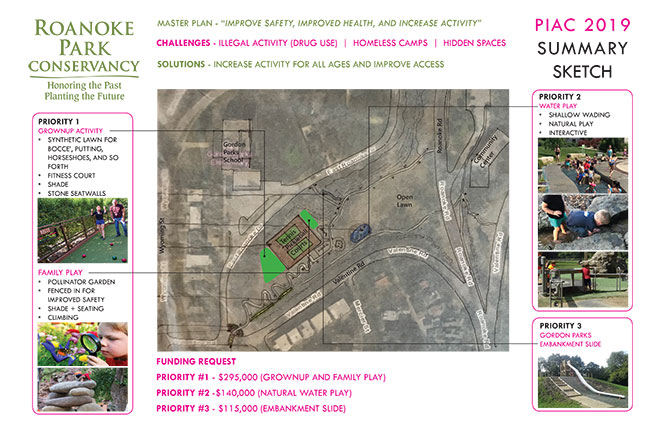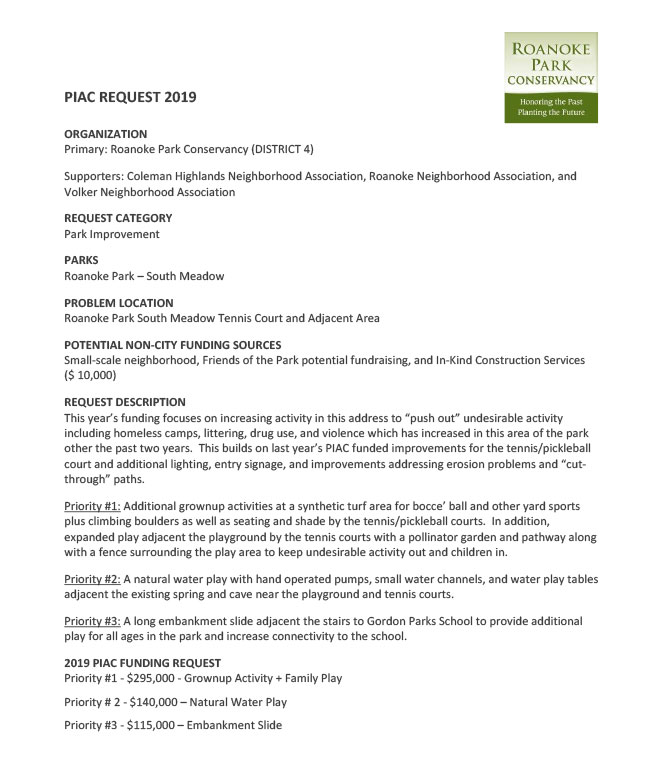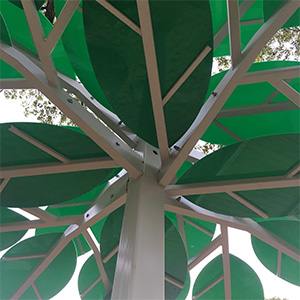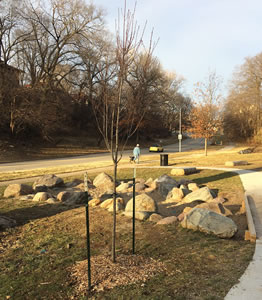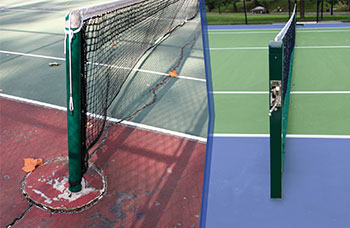 New tennis courts are on the way. Click for more pictures.
New tennis courts are on the way. Click for more pictures.
Roanoke Park Continues to Benefit from Public Infrastructure Advisory Committee Funds
Since it was founded the Roanoke Park Conservancy has worked with the parks department to seek PIAC funding for improvements throughout the park with great success. These requests have aligned with the 2011 Master Plan, and benefited from the strong support of nearby neighborhoods. The focus of the past few years has been improving the "south meadow," the lobe of the park southwest of the community center. These improvements include: renewing the tennis courts, new sidewalks, additional lighting, and entry pillars and signage.
The south meadow shows the results and more are on the way! Hopeful signs of good days after we make it through together.
Currently funded PIAC improvements will add to the already completed work within Roanoke Park’s south meadow: the 2014 playground replacement, the new sidewalk and lighting along the north side, the winding ADA sidewalk between the tennis courts / playground and the west entrance, and replacing the handrails on the north staircase. In 2018 we requested solving the erosion problems and shortcut paths along the winding sidewalk with durable flagstone paving, and entrance pillars / lighting at the southwest entrance. Those projects are winding their way through the process and may come to fruition later in 2020.
Most dramatically, this summer and fall you can expect to see the fruits of earlier PIAC requests in the form of NEW TENNIS COURTS. Yes, they will also be striped for PICKLEBALL. The purchase order for the tennis court contractor has been approved and pending any unforeseen delays (which there are a lot of these days) work should proceed in the months ahead!
In 2019, another master plan aligned request was made to continue the momentum: we hope to add amenities to the tennis court / playground area including: a naturalistic water play area as well as adult and family play areas next to the soon to be rehabilitated tennis courts. A future option is a new slide for the playground coming down through the trees next to the north staircase.
Click the images below to view pdf documents of the 2019 request. Unfortunately we have learned that the below request was not approved. We will reformulate it to refine the plans and TRY AGAIN next year.
Download the Master Plan and Ecological Restoration Master Plan at the links below.
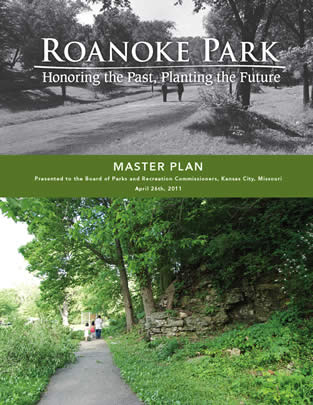
MASTER PLAN, 2011
The full Master Plan document is viewable and downloadable on Scribd: http://www.scribd.com/doc/54081928/Roanoke-Park-Master-Plan
The submitted document also included this foldout, replacing pages 41-42 in the above 8.5x11 only version: http://www.scribd.com/doc/54080750/RP-Master-Plan-Foldout
Articles can be found in this section of the website detailing the Master Plan creation, including the Park Planning Charrette, Notes from the Charrette, the Neighborhood Survey, and Master Plan Approved articles.
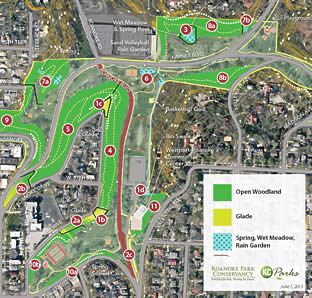
ECOLOGICAL RESTORATION MASTER PLAN, 2013
2013's Ecological Restoration Master Plan document is downloadable from: http://www.roanokeparkkc.org/66-uncategorised/156-restoration-plan
An article with some explanation can be found here: http://roanokeparkkc.org/plans/master-plan/153-let-s-talk-ecological-restoration-master-plan
Shade Structure by Egawa + Zbryk installed! Creative. Artistic. Functional.
It's in! The installation is complete of an artistic shade structure at the Karnes playground in the park. The piece 100% privately funded and was a cooperative effort designed by Rie Egawa + Burgess Zbryk (egawazbryk.com, instagram: @egawa_zbryk) and crafted at Hufft. The installation itself was donated by Kissick Construction. Of course Kansas City, MO Parks and Recreation approved the project at all stages. (These photos by @egawa_zbryk and Hufft workshop manager @sgb73 on Instagram.)
The piece it the fruition of a design competition held last year. (It was originally conceived as sitting atop the main mound in the playground, but that concept went away very early by consensus view of the architects, designers and construction professionals that weighed in.)
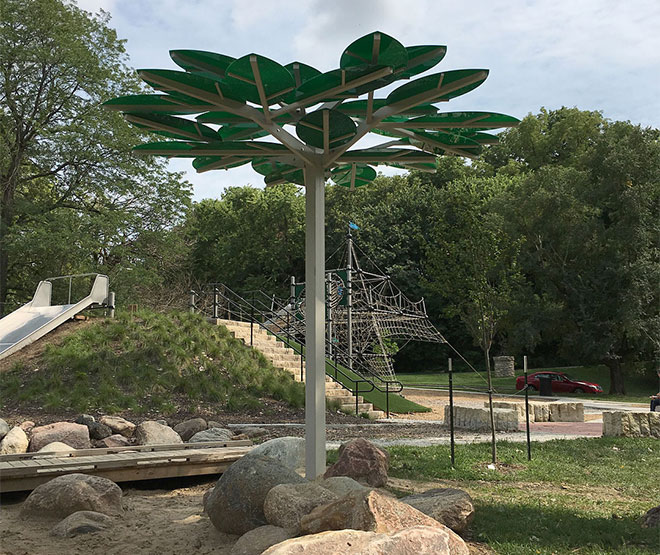
New trees are being planted in the park, at the Karnes playground and the sledding hill.
The Karnes playground has been a huge hit for Roanoke Park and its visitors. One complaint that has been heard however is that there can be a lack of shade on sunny days and the equipment can get quite hot. To address that concern, the Roanoke Park Conservancy's playground committee requested this past fall that more trees be planted by the parks department. Rachel Porter, Lance Klein and Chris DeLong worked together to pick the most desirable trees from the city's "contract planting list." Two fast growing and tall trees were chosen for the south side of the playground, where they could provide the most shade in the fewest number of years: a Northern Red Oak, and a Tuliptree (Tulip Poplar). A Sugar Maple was planted not far from the swing set, a Black Tupelo near the "council ring," and a Serviceberry near the boulders and sand. Lance's plan also calls for a White Oak closer to Karnes and a Caddo Maple north of the playground, but those have yet to be planted. Most of these selections are Missouri native trees with high wildlife value and all are handsome trees. We can hear the birds singing already!
Additionally, Lance and Chris requested that more trees be planted to replace those that have fallen or are in declining condition around the "sledding hill" west of Karnes. Two of those have already been planted, both Bur Oaks. North of the small blue swingset, a Bur Oak fell a couple years ago and you can still see the trunk and up-ended roots. Then recently a large White Oak fell not far away, blocking the trail until its rotted trunk was chain sawed out of the way. The trees on either side of the blue swingset are White Oaks that appear to be in decline. Lance and Chris requested that "replacement trees" be planted now near those two. Also requested was a Chinkapin Oak near Karnes, near where the stump is still visible from one of the parks old sentries that came down in 2011-12.
New Trees in the Park
Red Oak, Quercus rubra — 60–90’ tall. Fastest growing oak. Common in Roanoke Park's forest interior, on the middle shelf. Not super long lived (100-125 yrs).
White Oak, Quercus alba — 60-90’ tall. The park needs more of them since our largest ones are not in great health. Wide canopied large trees with deeply divided leaves and large acorns.
Sugar Maple , Acer sacharum 'Legacy'— 40-80’ tall. Dense shade and shallow roots tend to prevent grass from growing beneath them. Gorgeous fall color (see the big one north of Karnes, east of the spring).
"Caddo Maple", Acer sacharum ‘Autumn Splendor’ — 30-60' tall. Very good fall color, drought tolerant.
Tuliptree, Liriodendron tulipifera — 60-90’ tall. Fast growing. Not very valuable to wildlife. Not native to our part of the state but grows well. Attractive blooms.
Black Tupelo, Nyssa sylvatica ‘Afterburner Tupelo’ –– 30-40' tall. Nice shape (pyramidal when young) and glossy leaves. Its native range is only a few counties away. Also called Black Gum or Sour Gum, for the edible, but sour berries.
Serviceberry, Amelanchier laevis ‘JFS-Arb’ — 20-30' tall. Nice white spring flowers, edible berries, fall color. This is a single trunk selection of the east of the Mississippi species, also sold as 'Spring Flurry.' (Our local serviceberry species is Amelanchier arborea. A few exist within the park.)
Trees for the sledding hill include White Oak (detailed above), and...
Bur Oak, Quercus macrocarpa — 60-80’ tall. May be slow growing but grows into a large muscular tree. The twigs, often with corky bark extensions, are thick to support the golf ball sized acorns (largest of all oaks).
Chinkapin Oak, Quercus muhlenbergii — 40-60' tall. Most common oak in the park. Not as tall or fast growing as red oak, but has a beautiful semi-open wide crown and ‘gnarly’ branches. Squirrels go into a feeding frenzy on the acorns and gobble them into bits. Very long lived. (Chinkapins on Blue River Glade near Swope Park have been dated at over 200 years old. The larger ones in Roanoke Park are almost certainly as old.)
Roanoke Park News & Events
TRAIL INFO
Trail Maps, in various formats:
Roanoke_Park_Trails.pdf (417 kb).
Roanoke Park Trees and Trails Google Map
"Roanoke Park Tour" on MTBProject.com
To avoid damaging trails, check Trail Status before biking or hiking off road. ("Rozarks" = Roanoke Park's 2.5 miles plus Rosedale's 3.5 miles.)
Contact the Westport-Roanoke Community Center to find out about their facilities or inquire about reserving spaces.

